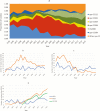Changing Characteristics of Staphylococcus aureus Bacteremia: Results From a 21-Year, Prospective, Longitudinal Study
- PMID: 31001618
- PMCID: PMC6853684
- DOI: 10.1093/cid/ciz112
Changing Characteristics of Staphylococcus aureus Bacteremia: Results From a 21-Year, Prospective, Longitudinal Study
Abstract
Background: We conducted a longitudinal study to evaluate changes in the clinical presentation and epidemiology of Staphylococcus aureus bacteremia (SAB) in an academic, US medical center.
Methods: Consecutive patients with monomicrobial SAB were enrolled from January 1995 to December 2015. Each person's initial bloodstream S. aureus isolate was genotyped using spa typing. Clonal complexes (CCs) were assigned using Ridom StaphType software. Changes over time in both the patient and bacterial characteristics were estimated with linear regression. Associations between genotypes or clinical characteristics and complications were estimated using multivariable regression models.
Results: Among the 2348 eligible participants, 54.2% had an implantable, foreign body of some type. This proportion increased significantly during the 21-year study period, by 0.96% annually (P = .002), as did comorbid conditions and acquisition outside of the hospital. Rates of any metastatic complication also significantly increased, by 0.94% annually (P = .019). Among the corresponding bloodstream S. aureus isolates, spa-CC012 (multi-locus sequence type [MLST] CC30), -CC004 (MLST CC45), -CC189 (MLST CC1), and -CC084 (MLST CC15) all significantly declined during the study period, while spa-CC008 (MLST CC8) significantly increased. Patients with SAB due to spa-CC008 were significantly more likely to develop metastatic complications in general, and abscesses, septic emboli, and persistent bacteremia in particular. After adjusting for demographic, racial, and clinical variables, the USA300 variant of spa-CC008 was independently associated with metastatic complications (odds ratio 1.42; 95% confidence interval 1.02-1.99).
Conclusions: Systematic approaches for monitoring complications of SAB and genotyping the corresponding bloodstream isolates will help identify the emergence of hypervirulent clones and likely improve clinical management of this syndrome.
Keywords: spa typing; spa-CC008; MRSA; USA300; clonal complex.
© The Author(s) 2019. Published by Oxford University Press for the Infectious Diseases Society of America. All rights reserved. For permissions, e-mail: journals.permissions@oup.com.
Figures



Comment in
-
The Importance of Staphylococcus aureus Genotypes in Outcomes and Complications of Bacteremia.Clin Infect Dis. 2019 Nov 13;69(11):1878-1880. doi: 10.1093/cid/ciz114. Clin Infect Dis. 2019. PMID: 31001630 No abstract available.
References
-
- Fowler VG Jr, Nelson CL, McIntyre LM, et al. . Potential associations between hematogenous complications and bacterial genotype in Staphylococcus aureus infection. J Infect Dis 2007; 196:738–47. - PubMed
-
- Nienaber JJ, Sharma Kuinkel BK, Clarke-Pearson M, et al. ; International Collaboration on Endocarditis-Microbiology Investigators Methicillin-susceptible Staphylococcus aureus endocarditis isolates are associated with clonal complex 30 genotype and a distinct repertoire of enterotoxins and adhesins. J Infect Dis 2011; 204:704–13. - PMC - PubMed
-
- Fernández-Hidalgo N, Ribera A, Larrosa MN, et al. . Impact of Staphylococcus aureus phenotype and genotype on the clinical characteristics and outcome of infective endocarditis. A multicenter, longitudinal, prospective, observational study. Clin Microbiol Infect 2018; 24:985–91. - PubMed

